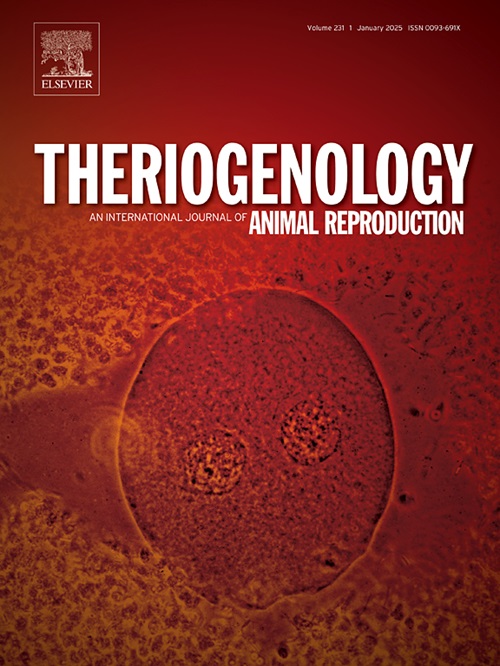Effect of the follicular stage and circulating progesterone concentrations at the beginning of an estradiol/progesterone-based synchronization protocol on profile of gonadotropins and follicle dynamics in beef heifers
IF 2.4
2区 农林科学
Q3 REPRODUCTIVE BIOLOGY
引用次数: 0
Abstract
This study evaluated the effects of the follicular stage (pre-vs. post-deviation) at the beginning of an estradiol (E2)/progesterone (P4)-based synchronization protocol, and of circulating P4 concentrations (higher vs. lower) during the protocol, on profiles of gonadotropins and development of a new follicular wave in Bos indicus heifers. Cycling Nelore heifers (n = 23; 24.0 ± 2.7 mo old) were pre-synchronized to initiate an E2/P4-based protocol (on Day 0) with either a post-deviation 7-d old follicle (F7d) or a pre-deviation 2-d old follicle (F2d) in the absence of a corpus luteum. Heifers were then assigned to a 2 × 2 factorial arrangement (follicular stage × P4 treatment), receiving either a new intravaginal 2 g P4 device (higher P4, HP4) or a 14-d used 1 g P4 device (lower P4, LP4), plus 1.5 mg of E2 benzoate. Ultrasound evaluations were performed on Days −10, −5, −2, and daily from Day 0–7. Blood samples were collected every 12 h from Day 0–5, and daily until Day 7. Statistical analyses were performed by SAS 9.4 (P ≤ 0.05). On Day 0, the diameter of the initial follicle (F0) was larger (10.7 ± 0.4 vs. 6.7 ± 0.2 mm; P < 0.01), the circulating E2 was greater (5.7 ± 0.9 vs. 2.7 ± 0.5 pg/mL; P = 0.01) and FSH concentrations were lower (0.15 ± 0.01 vs. 0.20 ± 0.01 ng/mL; P < 0.01) in F7d than F2d group. Mean P4 concentrations over time were greater in HP4 than in LP4 group (3.1 ± 0.1 vs. 2.0 ± 0.1 ng/mL; P < 0.01). No interaction effects were observed. Circulating FSH concentrations were greater (P = 0.02) in F2d than F7d group at 0 and 12 h, with no further differences, whereas no differences were observed in LH concentrations over time. The time of emergence (P = 0.73) and deviation (P = 0.81) were not affected by the follicular stage, nor the follicular growth until Day 7 (P = 0.41). Regarding P4 treatments, circulating LH was lower (P < 0.01) in HP4 than LP4 group at 12 and 24 h, with no further differences. FSH concentrations were similar (P = 0.89) from 0 to 60 h but increased from 72 to 120 h in HP4 group (P = 0.04). Although the time of emergence did not differ (P = 0.12), in HP4 group, the number of follicles (≥4 mm) was smaller (6.9 ± 0.5 vs. 9.4 ± 0.4; P < 0.01) and the time of deviation was slightly delayed (5.7 ± 0.2 vs. 5.2 ± 0.2 d; P = 0.04), compared to LP4 group. Moreover, although the follicular development by the time of deviation was not affected (P = 0.59), the follicular growth by Day 7 was slower in HP4 group, resulting in a smaller dominant follicle (7.7 ± 0.2 vs. 8.8 ± 0.4 mm; P < 0.01) and a tendency for lower E2 concentrations (1.1 ± 0.2 vs. 1.5 ± 0.3 pg/mL; P = 0.10), compared to LP4 group. In conclusion, the follicular stage at the beginning of an E2/P4-based protocol did not have major effects on gonadotropin secretion, nor on new follicular wave development. In contrast, higher P4 concentrations resulted in fewer subordinate follicles and increased FSH concentrations after emergence, slightly delaying the time of deviation. In addition, despite not affecting the follicle development during the common growth phase, higher P4 concentrations resulted in a smaller dominant follicle with reduced E2 production.
以雌二醇/黄体酮为基础的同步方案开始时卵泡期和循环孕酮浓度对肉牛促性腺激素和卵泡动力学的影响
本研究评估了卵泡期(前卵泡期和卵泡期)的影响。在以雌二醇(E2)/黄体酮(P4)为基础的同步方案开始时,以及在方案期间循环P4浓度(较高与较低),对促性腺激素和新卵泡波发育的影响。骑Nelore小母牛(n = 23;(24.0±2.7月龄),在黄体不存在的情况下,使用偏离后7天的旧卵泡(F7d)或偏离前2天的旧卵泡(F2d),在第0天预同步启动基于E2/ p4的方案。然后将小母牛分配到2 × 2因子安排(卵泡期× P4治疗),接受新的阴道内2g P4装置(高P4, HP4)或使用14天的1g P4装置(低P4, LP4),加1.5 mg E2苯甲酯。在第10天、第5天、第2天以及第0-7天每天进行超声评估。从第0 ~ 5天每12 h采集一次血样,直至第7天。采用SAS 9.4进行统计学分析(P≤0.05)。第0天,初始卵泡直径(F0)较大(10.7±0.4 vs. 6.7±0.2 mm);P & lt;0.01),循环E2更大(5.7±0.9 vs. 2.7±0.5 pg/mL;P = 0.01), FSH浓度降低(0.15±0.01∶0.20±0.01 ng/mL;P & lt;F7d组较F2d组明显增高0.01)。随着时间的推移,HP4组的P4平均浓度高于LP4组(3.1±0.1 vs. 2.0±0.1 ng/mL;P & lt;0.01)。未观察到相互作用效应。F2d组在0和12 h的循环FSH浓度高于F7d组(P = 0.02),没有进一步的差异,而LH浓度随时间的变化没有差异。卵泡期和第7天前的卵泡生长均不影响卵出时间(P = 0.73)和偏差(P = 0.81)。P4组循环LH较低(P <;在12和24 h时,HP4与LP4组比较差异无统计学意义(0.01)。FSH浓度在0 ~ 60 h无显著差异(P = 0.89),而在72 ~ 120 h有显著升高(P = 0.04)。虽然出现时间没有差异(P = 0.12),但HP4组卵泡(≥4 mm)数较少(6.9±0.5 vs. 9.4±0.4);P & lt;0.01),偏离时间略有延迟(5.7±0.2∶5.2±0.2 d;P = 0.04),与LP4组比较。此外,虽然偏离时间对卵泡发育没有影响(P = 0.59),但HP4组第7天卵泡生长较慢,优势卵泡较小(7.7±0.2 vs. 8.8±0.4 mm;P & lt;0.01), E2浓度有降低的趋势(1.1±0.2 vs. 1.5±0.3 pg/mL;P = 0.10),与LP4组比较。综上所述,基于E2/ p4的方案开始时的卵泡期对促性腺激素分泌和新卵泡波的发育没有重大影响。与此相反,P4浓度升高导致卵泡次级数量减少,卵泡脱出后卵泡刺激素浓度升高,脱出时间略微延迟。此外,尽管在正常生长期不影响卵泡发育,但较高的P4浓度导致优势卵泡变小,E2产量减少。
本文章由计算机程序翻译,如有差异,请以英文原文为准。
求助全文
约1分钟内获得全文
求助全文
来源期刊

Theriogenology
农林科学-生殖生物学
CiteScore
5.50
自引率
14.30%
发文量
387
审稿时长
72 days
期刊介绍:
Theriogenology provides an international forum for researchers, clinicians, and industry professionals in animal reproductive biology. This acclaimed journal publishes articles on a wide range of topics in reproductive and developmental biology, of domestic mammal, avian, and aquatic species as well as wild species which are the object of veterinary care in research or conservation programs.
 求助内容:
求助内容: 应助结果提醒方式:
应助结果提醒方式:


